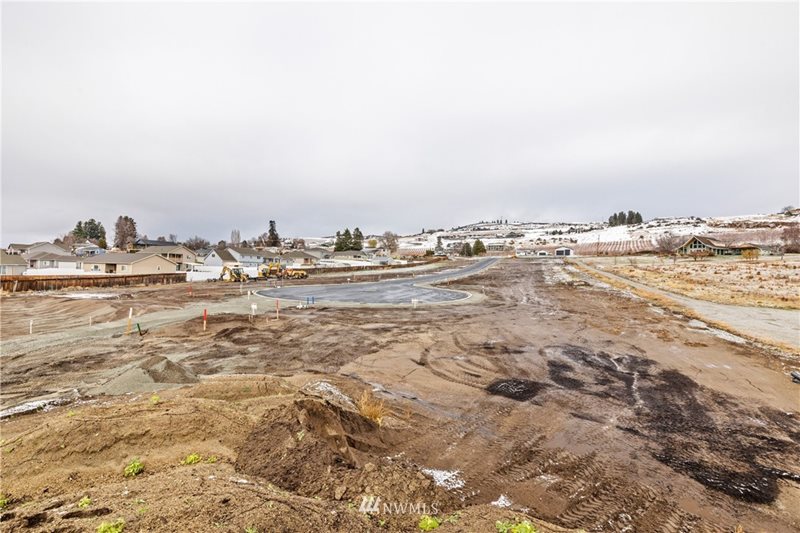
A lot in the Cameo subdivision is prepared for redevelopment. Photo credit: Eliu Peredo Photography
Many historical orchards have high levels of lead and arsenic from past pesticide use. As we move into spring construction season, it’s important to make sure developers know how they can clean up these prime pieces of property.
In June, we shared a blog that introduced pre-approved cleanup plans for such housing projects. The Model Remedies for Cleanup of Former Orchard Properties in Central and Eastern Washington, gives developers some flexibility and helps them plan for costs. It also provides buyers confidence about their property purchases.
Pilot project tests model remedies
During our conversation with stakeholders, a frequent concern was not just cleanup costs, but the availability of clean soil for construction projects. With that in mind, our Toxics Cleanup Program provided a $225,000 grant to Chelan County for a pilot project at a new residential subdivision in Manson, near Lake Chelan.
Talos Construction purchased five acres with plans to subdivide the parcel into 20 single-family residential lots for the Cameo Residential Development. Testing showed high amounts of lead and arsenic in the soil. This provided an opportunity to evaluate how well the new model remedies work. It also allowed us to make sure future homebuilders and contractors have the tools they need to clean up legacy pesticides as required under state law.
"This project is something to be proud of," said Mindy Hibbard, the managing broker with John L Scott Real Estate, for the development. Cleanup is at a point where homes and lots are now for sale, and open houses are being conducted.
The pilot found that cleanup costs about $5,000 on average per parcel.
What this means for new home builders
When former orchards are considered for new housing or commercial development, Ecology is concerned about the impact to the health of the community. Arsenic and lead are toxic metals. Exposure can increase the risk of certain health problems. Although these metals are not easily absorbed through the skin, living in close proximity to soils contaminated with lead and arsenic could result in ingestion of soil and inhalation of dust.
Testing will establish what needs to be cleaned up. In some areas, contaminated soil will need to be excavated and replaced with clean soil. “Hardscapes” like parking spaces or buildings can provide a permanent barrier to exposure. “Softscapes” like lawns and areas of permeable gravel also may be sufficient protective measures.
At the Cameo project, the developer is responsible for cleaning up common areas, like roads and sidewalks. Future homebuilders at the development will be responsible for creating hardscapes and softscapes as needed on their individual lots. Development agreements are recorded with the Chelan County Auditor''s office to make sure property owners are aware of their obligations.
What the Ecology grant paid for
Our grant to Chelan County for the Cameo project was used to find and buy enough clean soil to cover residential lots as they are developed. The grant also helped pay for technical assistance and guidance to ensure the project was a success. Documents and forms were created for future use, including development agreements and cleanup certification forms. Finally, materials are being drafted to provide information on lead arsenate pesticide contamination and the model remedy process. That information is available on our Former Orchards Webpage.
Talos worked with Chelan County’s consultant, Aspect Consulting, to identify several off-site sources of suitable soil. This meant reaching out to local landscape suppliers, sand and gravel suppliers, as well as construction and excavation companies. Site visits and sampling took place at promising sites to assure sources were free of lead arsenate pesticide. Approximately 2,650 cubic yards of clean soil was determined to be necessary for the Cameo Development.
Next steps for local communities in Central Washington
One major challenge for developers dealing with pesticide contamination is sorting out state and local regulations.
While developers are familiar with local land use regulations and permit requirements, they may not understand state rules protecting people from exposure to toxic chemicals. We know we need to clarify these cleanup requirements. Under the state's Model Toxics Control Act, contaminated lands must meet standards established to protect public health and the environment, independent of local government land-use decisions. Ecology is charged with enforcing these regulations. As redevelopment of former orchards is rapidly expanding in the region it's important for developers to understand these rules.
Last year, we received funding from the Legislature to work on the feasibility of creating a clean soil bank, and to help design appropriate landuse and development codes for local cities and counties to adopt related to such cleanups. This will help local jurisdictions and developers understand what is expected.
Coming up: Our next blog will highlight how to integrate the Model Remedies for Cleanup of Former Orchard Properties in Central and Eastern Washington with local land-use permits and processes.
More information
- Link to Former Orchards Webpage
- Link to the orchard maps page
- For information, email FormerOrchards@ecy.wa.gov

